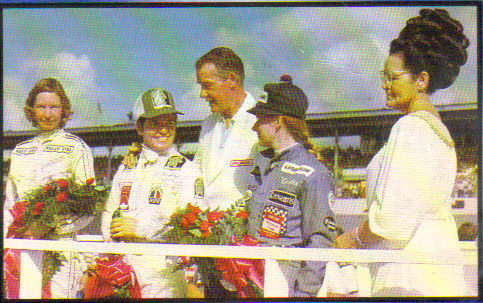Arlene Hiss was the first woman to qualify for and complete an Indycar race, in 1976.
Her single Indycar outing was at Phoenix. Although badly off the pace, she reached the finish in fourteenth. Plans had been set out for Arlene to compete in the Indy 500, but they never came to fruition and the honour of being the first woman at Indy went to Janet Guthrie.
At the time of the Phoenix race, Arlene was 35 and divorced from racer and crew chief Mike Hiss. She had raced as an amateur for almost 13 years previously, winning three consecutive SCCA Showroom Stock championships in the 1970s. Despite her long association with motor racing, she was never a professional driver and made her living teaching high school, mainly dance but later on, car maintenance.
As Arlene Lanzieri, she began racing in 1964, in an Austin-Healey Sprite that she sometimes shared with Shirley van Kleeck until 1966. Among her early rivals was Donna Mae Mims. Arlene and Shirley competed that year as “The Female Racing Team” and were sponsored by Stan Engleman Enterprises. They were competitive in the H-Production class, with Arlene normally the faster driver.
This was when she and Mike got together at a race circuit in Connecticut, according to a 1970 article in the Monrovia Daily News Post. Arlene helped to crew his junior single-seaters as he progressed through the pro ranks, as well as racing her own Sprite in the H-Production championships. Due to her crew commitments, she was unable to contest full championships although she was a quick driver.
Her switch from sportscars to stock cars was partly due to Mike’s increasing success. He was named as the 1972 Indy Rookie of the Year and was subsequently unavailable to act as her crew chief. Arlene responded by buying an Opel 51 which she could drive to and from the tracks herself, according to the Indianapolis Star in 1973.
She had been entered into the Phoenix event by Copper State Racing, in a 1974 Offenhauser previously used by Lloyd Ruby. Her USAC license, earned during a stock car race, would have allowed her to also take part in the second round of the Indycar championship at Trenton, but Lloyd Ruby drove instead.
Her single-seater debut was well-received by the press but not so much her fellow drivers. After the Phoenix race, Bobby Unser, Gary Bettenhausen and Bill Vukovich II were all scathing in their criticism of Arlene, accusing her of dangerous driving by going too slowly and taking the wrong lines. Unser blamed the media for pressuring USAC into licensing a female driver who was not ready. Neither Bettenhausen or Vukovich had qualified.
Arlene’s testing times were acceptable if not world-beating and she had managed to qualify for the race in the 21st of 22 grid spots, from 24 qualifiers. Her qualifying times were slower than her test times and her race pace was even slower.
Much later, in her autobiography, Janet Guthrie tells of how established male drivers encouraged her to hold her line when being passed by faster drivers, instead of moving off the racing line and allowing them to pass. In practice, this was a foolish idea, which she soon found out. Having watched Arlene race, Janet is convinced that she was acting on similar bad advice. A newspaper reported that the car’s owner Mike Devin had admitted giving her this guidance.
Janet also observed that Arlene’s head was bent over at an angle as she cornered. Most other drivers of the time used some sort of headrest or strap, but Arlene did not. This may have caused discomfort and affected her pace.
Arlene attended another test with Copper State at Ontario, but this was her last involvement with the team. She claimed in the papers that this was down to a lack of funding, rather than the criticisms she had received.
After her retreat from single-seater racing, she attempted to break into NASCAR, entering the Los Angeles Times 500 at Ontario Motor Speedway in a Chevrolet sponsored by Let’s Eat Out. Sadly, despite her previous stock car experience, she was one of a large number of drivers who did not make the 40-car grid.
She did manage to qualify for a round of the USAC Stock Car series in June. Arlene was one of two women to enter the Texas 500, alongside Martha Wideman. She finished ninth overall and would have been even higher up without tyre trouble early on. This time, AJ Foyt was complimentary about her driving. In October, she was invited to the Long Beach street circuit by Toyota to race a Celica in a forerunner of the Toyota Pro-Celebrity race.
She retired from the circuits in 1978, having struggled to find sponsorship.
(Image from flashbak.com)






